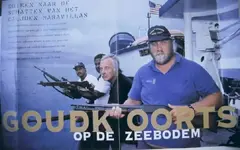Alexandre said:
Wonderful pics, Oceanscience. Keep them coming.

You see, quite unlike the Bahamas, Brazil would be the right place to have a underwater archaeological museum - they have the shipwrecks, there are millions of Brazilians (São Paulo is the seventh largest city in the world, and number one of the southern hemisphere), and a great majority of them are educated and jut love to have knowledge of their past; the biggest inflow of Brazilian tourists in Portugal is composed of people wanting to know from where were their ancestors). Not only that, but the economy is soaring (it even surpassed Uk's economy last years).
I am going through the pictures of the Santa Ecolastica, in search of Olive Jars. I can't remember any, but maybe I find a shard in the pictures.
In your list you have several "Rosarios". I dove on 2 shipwrecks of that name, If you give some more information, like date and location, I can give some information about the ones I dove on.
Forum threads are fed by feedback. If you supply some information about the shipwrecks you are looking for, other people will come up with some information too.
We can all learn from the information.
About Museums:
The local people usually show little interest in museums. Tourists from far away represent the majority of the visitors.
A place like Nassau, Bahamas is ideally suited for a theme park, where the colorful story of the archipelago's past could be told.
I say the story of the the past, the lore and legends, punctuated and visualized with palpable evidence, in the form of artifacts, to prove their truth. The theme park is only as good as the story tellers skill in telling the story.
For many people, specially in the USA, the words history and museum are boring subjects. Mel Fisher knew that and this is why he called his place a treasure exhibit. His first exhibit was on a replica Galleon, until she sank for the last time. I still remember what she looked like, but not her name.
Peter Throckmorton edited a book, "History under the Sea" however, the US publisher changed the name to "The Sea Remembers", because of the stigma that the word "history" carries in the USA. Apparently the stigma comes from the way that history is being thought at school. (Boring subject)
30 years ago, when I was diving the shipwrecks in Brazil, nobody had any interest in history, shipwrecks or archaeology or artifacts. People considered me a fool, for wasting my time recovering trash from the bottom of the ocean.
The first finders of the Santa Ecolastica, poked on her with an airlift. They happened on one of the cash boxes. It contained a few gold coins and a simple thick (about 30mm x 4mm, we found that one) gold wire and some 500 8 Reales and some of the newly minted Brazilian silver coins.
The silver coins were encrusted of course, so the divers did not recognize them as coins. The airlift scattered the 500 coins all over the wreckage, where we found them, wondering how the wreck seemed to be covered by a rain of silver coins.
They sold the gold coins to a dentist to melt down for tooth fillings and went back to harbor dredging, that at least paid for their daily bread and butter.
When I took a Chinese porcelain cup (from one of the "Rosario's, 1737), to an antique dealer in Rio De Janeiro, he asked where it came from. From the bottom of the sea. "Then it can only be trash that somebody dumped" he said. "We buy our antiques with reputable dealers in London and Paris, we do not buy trash."
As I left the posh shop, red faced, I saw an identical Chinese porcelain cup in the window. It was cracked and had no lid, while mine was perfectly intact and had it's lid.
Have things changed? I don't know. I know that I learned a lot in the meantime. Some about Museums too.
Anyway, my total dive time on the Santa Ecolastica is about 20 hours, including the time with Albanese. I reckon about 70% of the shipwreck is still there, including the scatter trail, where she spilled her guts including the cobs, mingled in the ballast (picture above), before she came to the final resting place.
Ah, yes, the scatter trail goes in a straight line to the skeleton of the sperm whale. Rather a weird coincidence I would say.
One more thing, the Greek freighter "Artemis" with 35,000 tons of iron ingots, nearly sank on top of
the Santa Ecolastica. However, the strong tide dragged the big ship another mile to the south-south east.
Towards the south-southwest, a short distance away, there is the ammunition dump.
And my drawing is from the time I was diving on her. Sometime after, the seismic survey ship snagged it's array on the wreckage of the Santa Ecolastica. this may have "re-arranged" the cannon and anchors a bit.





 yep , by mixing up one " our lady of sorrows" with another one --it could lead you to the totally wrong spot , and be a hundreds of year or more off course from what your looking for . --madding isn't it?
yep , by mixing up one " our lady of sorrows" with another one --it could lead you to the totally wrong spot , and be a hundreds of year or more off course from what your looking for . --madding isn't it?




